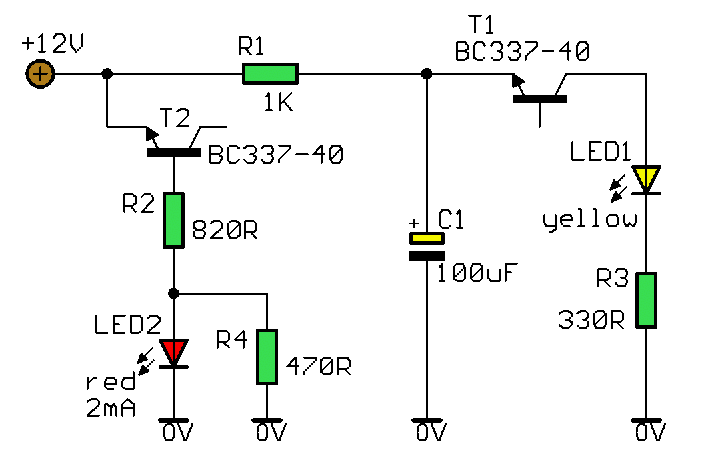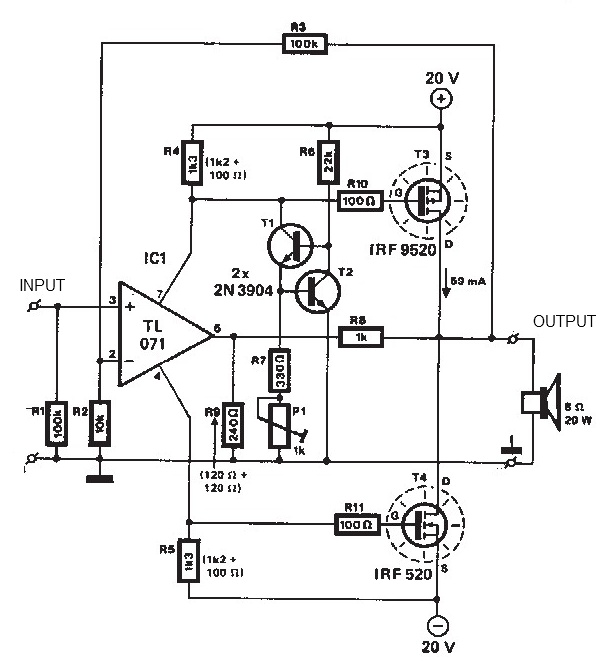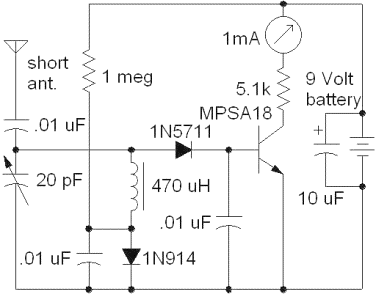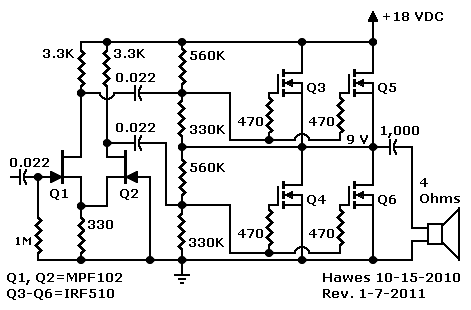
Positive And Negative Voltage Power Supply
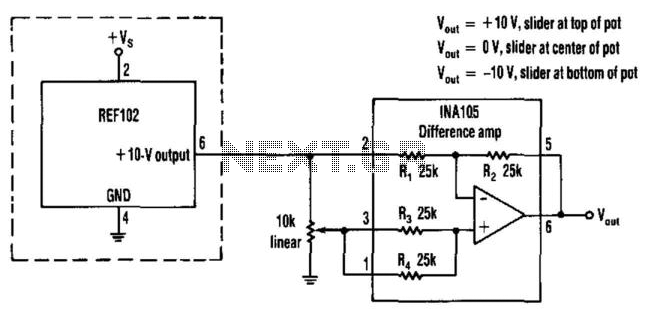
This circuit provides a precision voltage source that can be adjusted to produce zero, positive, and negative voltages, eliminating the need to reverse connections on the power supply. It allows for achieving exactly 0 V without any offset. The circuit operates using a linear gain-control amplifier that ranges from -1 V/V to +1 V/V. A Burr-Brown INA105 difference amplifier is configured as a unity-gain inverting amplifier. A potentiometer is connected between the input and ground, with the potentiometer's slider linked to the non-inverting input of the unity-gain amplifier, which is typically grounded. When the slider is positioned at the bottom of the potentiometer, the circuit functions as a standard precision unity-gain inverting amplifier with a gain of -1.0 V/V ± 0.01% maximum. Conversely, when the slider is at the top, it operates as a precision voltage follower with a gain of +1.0 V/V ± 0.001% maximum. When the slider is centered, the circuit achieves equal positive and negative gain, resulting in a net gain of 0 V/V. The overall accuracy between the maximum and minimum settings is primarily determined by the precision of the potentiometer.
This circuit design utilizes a Burr-Brown INA105 difference amplifier, which is known for its high precision and low offset voltage characteristics, making it suitable for applications requiring accurate voltage references. The choice of a potentiometer for gain control provides a user-friendly method for adjusting the output voltage range seamlessly. The configuration allows users to fine-tune the output voltage between the specified limits while maintaining a high degree of accuracy.
The inverting amplifier configuration with a gain of -1.0 V/V ensures that the output voltage is an inverted version of the input voltage, which is particularly useful in applications where signal inversion is necessary. The precision of the circuit is enhanced by the INA105's low noise and high common-mode rejection ratio (CMRR), which minimizes the impact of external noise on the output voltage.
In practical applications, the circuit can be employed in laboratory settings, test equipment, or any scenario where a stable and adjustable voltage reference is required. The ability to achieve exactly 0 V without offset is particularly advantageous in calibration tasks or when interfacing with sensitive electronic components that require precise voltage levels.
Overall, this precision voltage source circuit exemplifies effective design principles in analog electronics, combining high-performance components with user-adjustable features to meet the demands of various electronic applications. This circuit provides a precision voltage source that can be adjusted through zero to positive a nd negative voltages, which eliminates reversing connections on the power supply. Also, it is possible to get exactly 0 V, without some offset. As to how this circuit works, first consider the -1 V/V to +1 V/V linear gain-control amp (see the figure). A Burr-Brown INA105 difference amp is used in a unity-gain inverting amp configuration. A potentiometer is connected between the input and ground. The pot"s slider is connected to the noninverting input of the unity-gain amp; this input is typically connected to ground.
With the slider at the bottom of the pot, the circuit is a normal-precision unity-gain inverting amp with a gain of -1.0 V/V ± 0.01% maximum. With the slider at the top of the pot, the circuit is a normal-precision voltage follower with a gain of ± 1.0 V/V ± 0.001% maximum.
With the slider in the center, there"s equal positive and negative gain for a net gain of 0 V/V. The accuracy between the top and the bottom will usually be limited by the accuracy of the pot.
This circuit design utilizes a Burr-Brown INA105 difference amplifier, which is known for its high precision and low offset voltage characteristics, making it suitable for applications requiring accurate voltage references. The choice of a potentiometer for gain control provides a user-friendly method for adjusting the output voltage range seamlessly. The configuration allows users to fine-tune the output voltage between the specified limits while maintaining a high degree of accuracy.
The inverting amplifier configuration with a gain of -1.0 V/V ensures that the output voltage is an inverted version of the input voltage, which is particularly useful in applications where signal inversion is necessary. The precision of the circuit is enhanced by the INA105's low noise and high common-mode rejection ratio (CMRR), which minimizes the impact of external noise on the output voltage.
In practical applications, the circuit can be employed in laboratory settings, test equipment, or any scenario where a stable and adjustable voltage reference is required. The ability to achieve exactly 0 V without offset is particularly advantageous in calibration tasks or when interfacing with sensitive electronic components that require precise voltage levels.
Overall, this precision voltage source circuit exemplifies effective design principles in analog electronics, combining high-performance components with user-adjustable features to meet the demands of various electronic applications. This circuit provides a precision voltage source that can be adjusted through zero to positive a nd negative voltages, which eliminates reversing connections on the power supply. Also, it is possible to get exactly 0 V, without some offset. As to how this circuit works, first consider the -1 V/V to +1 V/V linear gain-control amp (see the figure). A Burr-Brown INA105 difference amp is used in a unity-gain inverting amp configuration. A potentiometer is connected between the input and ground. The pot"s slider is connected to the noninverting input of the unity-gain amp; this input is typically connected to ground.
With the slider at the bottom of the pot, the circuit is a normal-precision unity-gain inverting amp with a gain of -1.0 V/V ± 0.01% maximum. With the slider at the top of the pot, the circuit is a normal-precision voltage follower with a gain of ± 1.0 V/V ± 0.001% maximum.
With the slider in the center, there"s equal positive and negative gain for a net gain of 0 V/V. The accuracy between the top and the bottom will usually be limited by the accuracy of the pot.
